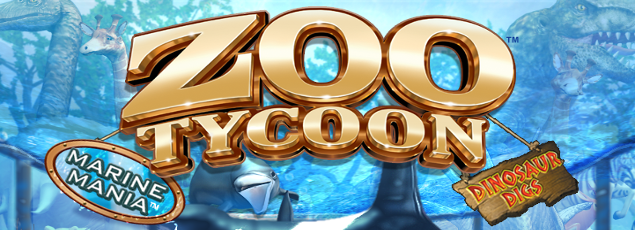
My whole life, I've loved zoos; they're places that let you bask in the seemingly limitless colour and variety of the animal kingdom. There are almost no environments on Earth which are inhospitable, and evolution has ingenious means for adapting organisms to both extreme and forgiving biomes. Zoos not only let us peek in on those organisms but also break down the barriers between those environments. You can be standing by a rock pool watching penguins squawk and swim, walk a short distance and see zebra grazing on the plains, and then, a few minutes later, witness chimpanzees swinging from the treetops. 2001's Zoo Tycoon provides the fantasy of constructing that pageant of flora and fauna for other people.
Background
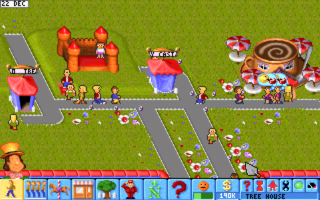
What's impressive about Zoo Tycoon is not just the splash it made in the business management genre, but also that it was able to make such waves when it was the first project undertaken by developer Blue Fang Games. Although, you've no doubt recognised that the concepts that would eventually converge in Zoo Tycoon were being fleshed out by the industry long before 2001. In fact, there have been so many fingers in the business sim pie that tracing back the influences and history behind Zoo Tycoon is no mean feat. Just based on their titles, release dates, and pitches, we might conclude that Zoo Tycoon was springboarding off of the success of Chris Sawyer's Rollercoaster Tycoon from 1999, and it was, but that game took lessons from Bullfrog's 1994 simulator, Theme Park.
Rollercoaster Tycoon was also a continuation of the style Sawyer had established with his 1994 sim Transport Tycoon which probably wouldn't exist if MicroProse had not released Sid Meier's Railroad Tycoon in 1990. Railroad Tycoon likely wouldn't have hit PCs in its final form if it weren't for co-designer Bruce Shelley also having worked on the beloved 1986 board game 1830: The Game of Railroads and Robber Barons, created by Avalon Hill. It was also inspired by 1989's SimCity from Maxis which grew out of the map editor from Brøderbund's Raid on Bungeling Bay, released in 1984. Will Wright, the designer of SimCity, took inspiration from the 1965 short story by Stanislaw Lem, The Cyberiad, and from the theory of systems dynamics which was developed throughout the 90s and late 80s by systems scientist Jay Wright Forrester.
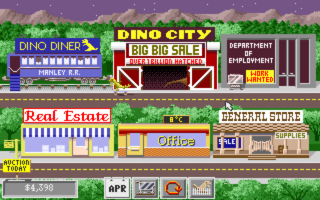
Zoo Tycoon was also not the first zoo management game. As best I can tell, that was 1993's DinoPark Tycoon from Manley & Associates. You'd think DinoPark Tycoon was inspired by Spielberg's film adaptation of the 1990 Michael Crichton novel Jurassic Park, but considering that it came out the same year as the film, it's possible that this game was taking cues directly from the Crichton book or even that its premise was unrelated to both. You could also unearth some light ecosystem management elements in Maxis's SimPark in 1996 and SimSafari in 1998, as well as Viridis Corporation's Eco East Africa in 1995. My point is that with such a rich taxonomy behind it, Zoo Tycoon wasn't groundbreaking, it was just another iteration in an evolutionary line that had existed for years. However, in some senses, this makes its success even more impressive. When there was a whole ecosystem of management strategy games out there, Blue Fang's brainchild still managed to make a name for itself, and that happened because of the game's tight feedback loops, the way its settings characterised its animals, and because it let us get so deep into the particulars of building parks. There's a lot of material in Zoo Tycoon's gene pool which got it to that point, but if we want to keep it manageable, we can view it as a synthesis of theme park games like Rollercoaster Tycoon and the earlier zoo sim DinoPark Tycoon.
From DinoPark Tycoon it takes the capacity for audiences to add animals, fence types, and terrain to zoos, as well as the task of organising the finances and staff surrounding the attractions. But DinoPark Tycoon didn't allow for freeform building and only gave players pre-drawn enclosure spaces which they could wrap up in a handful of skins. The experience also frequently required players to cut away to other menus to maintain the park, making the pacing of the game choppy. It was sims like Rollercoaster Tycoon which introduced the concept of the player deciding where the paths and attractions in the park should be situated and which allowed us to manage them under a single UI, allowing for more seamless interaction. Zoo Tycoon takes the immersive elements and breadth of customisation we saw in Rollercoaster Tycoon and its ilk and applies it to the subject matter and some of the base mechanics in DinoPark Tycoon.
Zoo Tycoon
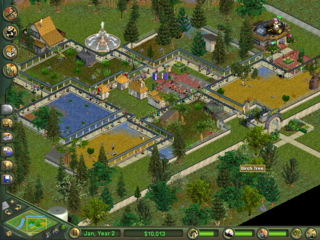
In Zoo Tycoon, as in most financial management games, we affect the world primarily through the placement of objects. This means we care for animals mostly through installing environmental features in their enclosures as opposed to micromanaging their diet as we do in DinoPark Tycoon or getting hands-on with them as in Nintendogs. Because the game places such a weight on building out the animals' homes, the difference between a mediocre zoo and an award-winning one is often how suitable the enclosures are for their occupants. It's that we get to design those exhibits instead of just plonking down prefab attractions which makes Zoo Tycoon stand head and shoulders above so many of its peers. In 1994's Theme Park, you can place down teacup rides or bouncy castles, but every one of them is identical; for the most part, your rides look the same as the rides in your friends' games. In Zoo Tycoon, the shape of the pen, every square of the internal terrain, the number and names of the animals in the enclosures, and the trees and rocks in the habitats are all down to the person holding the mouse. This wasn't an entirely foreign concept: Rollercoaster Tycoon and Theme Park did let you lay custom paths for rollercoaster tracks, but Zoo Tycoon was an amusement park game where two parks could look different in a way that hadn't been possible in the sims before it.
Part of what we're looking for when we pick up one of these object-placement simulators is a model-building kit. In Railroad Tycoon, we're making a model railway, and in Cities Skylines, we're building a model city, but we're doing it without needing the expertise and resources that constructing actual models requires. Developers can also simulate more moving parts in video games than you'd get with real-world miniatures, although it varies a little by the theme of the game. For example, there are moving trains in Railroad Tycoon, but you can also buy miniature electromechanical trains to set up in your home. With a game like Rollercoaster Tycoon, its rollercoasters do have equivalents in real-world miniatures, but they're not widely available, and you're not going to be able to simulate a park of fully-animated guests with the fidelity that a video game can. As a virtual model-building kit, Zoo Tycoon excels because of how detailed your model can be, and when you can paint in more detail, you can start stamping on the many differences that turn a model into your model. Additionally, creating animals that animate as naturally as those in Zoo Tycoon would be impossible with real-world miniatures. On the game design side, while you may be able to place down decorative items like rocks and trees in other games, Zoo Tycoon gives you a mechanical reason to do so.
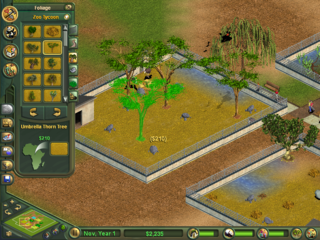
Most gameplay systems treat decorative items as functionally useless. They may be pleasant for the player to look at or help them to customise their world, but NPCs don't generally react to them. In Zoo Tycoon, these aesthetic objects are everything. They can make the human parkgoers a little happier, and vitally, they're what help animals to feel at home. By rewarding us for laying down habitats that animals will respond positively to, the design pushes us to build an environment that's pretty and appropriate to the animals we're exhibiting. Like many classic games of its stripe, Zoo Tycoon comes down at the sweet spot between using constructive tools to give us creative freedom and using mechanics to provide a guiding hand in that creation.
Over time, those mechanics give you the odd sense that the guests and the animals in these zoos are not all that different, precisely because we're placing down objects to keep both of them satisfied, and in the case of the parkgoers, to keep them opening their wallets. And there is a lot of overlap between the needs of the guests and the needs of the animals; for example, they both need us to supply them with food, and both respond to the aesthetics of their environment. We might view the guests as somehow above the animals because they're people like us, but under the mechanics, both humans and animals are part of a carefully-controlled system used to elevate their mood and leverage them for profit. On which note, as your zoo is a business venture, it's possible to play this game in a style where you care about guest happiness or your income above all else, and therefore, commoditise your animals, but Zoo Tycoon also suggests that zoos bring out an unusual economic symbiosis between humans and animals. Guests pay to see the fauna, and that income is then reinvested to purchase more animals and keep existing residents of the zoo relaxed and comfortable, which makes guests happier, which means more spending, and so on.
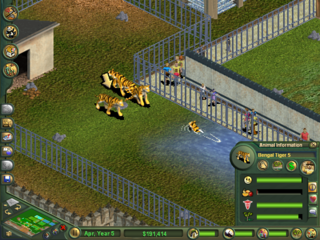
Zoo Tycoon can sometimes be a little cold in its reduction of animals to monetary investments and its generating of creatures with algorithmic names like "Giraffe 4", but unlike management games more focused on formal systems, it gives you no brownie points for lining your pockets at the expense of anyone's happiness, human or not. The guests empathise with the animals and will storm out if they find you're mistreating them, and the inter-reliance between guest happiness, animal happiness, and revenue means that neglecting your animals creates a net negative and that pure profiteers don't get ahead. Although, while such a system does encourage the player to nurture customers and animals, it's arguable that it also miseducates them about how much unethical behaviour a zoo can get away with. In this fiction, guests can read the mood of animals on-sight and are always outraged to find those animals are miserable. Additionally, animal suppliers will always meet your sustained mistreatment of animals with an embargo until you return your zoo to an acceptable state. But in the real world, it's sometimes the case that zoo patrons don't know or don't care about such mistreatment or that there is no inspection body limiting cruel zoos from obtaining animals. There are plenty ofdocumentedinstances of zoos holding animals in abhorrent conditions without having to shut down. Just a heads up, you may find the content behind those links distressing.
Under other circumstances, I also might accuse Zoo Tycoon of being reductionist about its characters' psychology, but it has a decent excuse. The central characters in this game are the animals, and their wellbeing is reduced to their fullness, their health, and whether or not they feel at home. While other games in this genre often apply this limited palette of emotions to humans and end up with portraits of people that are too rudimentary to be believable or fully empathetic, it works for these more emotionally simplistic creatures. It's also true that the humans in the game base their happiness on just a few uncomplicated factors; however, the game doesn't have to model every aspect of your visitors' lives, it just needs to emulate the elements of them that are relevant to their experience as zoogoers.
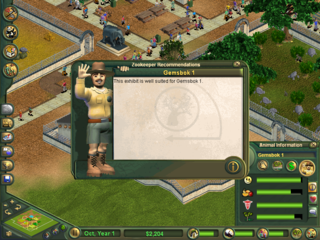
But at a certain point, the lines that provide you feedback on your animals and patrons go dead, interrupting your emotional connection with them. For example, picturesque scenery is something the guests' value, but no meter tells you how agreeable they find your zoo's appearance which also means you have to make educated guesses about how well you've beautified the environment. Similarly, trying to get to a 100% happiness rating on an animal is an agitating process. Zookeepers will recommend specific changes to enclosures up until an animal has a happiness rating of roughly 90%. After that, there are plenty of actions you can take to make those exhibits more comfortable for their occupants, but it becomes a guessing game of working out how many rocks or pieces of foliage they want or what percentage of their enclosure should be which terrain type. The game accuses you of being an imperfect manager when really, it's taking away the management tools which put you inside peoples' and animals' heads.
Dinosaur Digs
The first expansion to Zoo Tycoon, Dinosaur Digs, released in 2002. While its dinosaurs are functionally regular animals with more 0s on their price tags, that's perfect for anyone who built a highly lucrative park in the original experience and then had nowhere to put their hundreds of thousands of spare dollars. Games often have to make the items in their expansion packs more expensive as they are targeted at players who've gotten beyond the vanilla experience's endgame, but expansions frequently struggle to provide explanations for why the items in them are more expensive than those in the base catalogues. Dinosaur Digs gets it right; it's believable that raising these ancient lizards from the dead and keeping them alive would drastically increase expenditure.
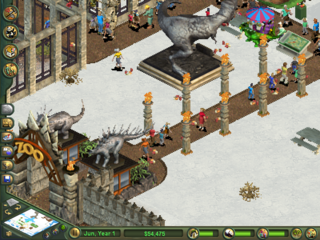
It's the same thing that happened in Jurassic Park, and the inspiration from that film is highly evident here. Not just in this expansion's premise of a dinosaur zoo, but also in the set decoration that includes the flaming torches and electric fences from Spielberg's mythical island, as well as the frequent reminders that the reversal of the dinosaurs' extinction is a product of radical scientific breakthroughs. You don't take care of these beasts with zookeepers; you assign scientists to them who come complete with the compulsory lab coat and clipboard. There's even a whole research track just for unlocking new forms of care for the t-rex. This research path, the t-rex's exceptionally high price, and the animal's unparalleled aggression make sure that, as in Jurassic Park, it's presented as the headline act. This does come with the disadvantage of the endgame taking you by the hand and leading you back to the same animal every time, whereas the base game put most animals on equal footing and gave you a variety of late-game purchases you could make. On the other hand, it makes the t-rex as imposing in the mechanics as it is physically.
Another commonality between Jurassic Park and Dinosaur Digs is that both pieces of media build towards a couple of key moments: The hatching of the dinosaur egg and the calamitous breakout. All dinosaurs in this add-on start life as eggs, making their true arrival not when you pick them out of the shop but when they crack out of their shell. That hatching becomes its own event which draws no small amount of attention. You'll also find that you need electric fences to contain these temperamental beasts; the expansion borrows a trick from the film by signalling the danger the dinosaurs pose through the locktight measures required to hold them. Before you've even added a dinosaur to their cage, the sparking iron bars of their exhibit walls let you know something ferocious is on its way.
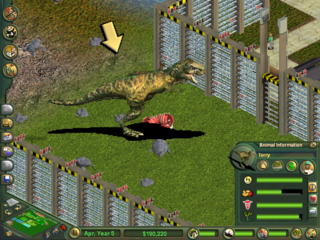
Where Dinosaur Digs begins to deviate from Jurassic Park is that not everything on its manifest is a prehistoric lizard. The developers retain some of the bedrock game's commitment to broad representation of the animal kingdom through including not just one clade of extinct beings, but also sabre-toothed tigers, plesiosaurs, and plenty of other long-dead wonders. That you can successfully acquire all these prehistorical marvels and keep them captive also constitutes a philosophical disagreement between Dinosaur Digs and Jurassic Park. In the latter, it's only through self-serving hubris that the managers of the park believe that they can keep these monsters under lock and key, but in this expansion, it's not a fantasy, it's an attainable goal. What's more, while the breakouts in Jurassic Park constituted the deal knell of the zoo, in Dinosaur Digs, you can swiftly mitigate the effects of an allosaurus escape here, or a velociraptor running wild there. Have the rescue team capture the animal and repair the fence and your zoo's reputation will heal back up well in time for the next financial quarter. This expansion says a dinosaur gaining free reign of your pathways may sound scary, but what theme park hasn't had one or two customers eaten alive? It's a logical contrivance to an extent that you don't see in the vanilla game and what really stops me suspending my disbelief is the way that you have to combat against dinosaurs making a bid for freedom, in the first place.
Ideally, any weak fences on the prehistorical animal exhibits would be promptly patched up by a maintenance worker, but while you can assign a zookeeper to take care of specific enclosures, you can't do the same thing with the employees in charge of repair. You'll also find they won't automatically snap-to after realising an electrified fence has rusted and weakened; they'll complete any number of trivial jobs before mending worn-out fences on dinosaur exhibits. Expansion packs for games where we are reliant on AI cannot simply provide us new missions; they also have to ensure that their AI is smart enough to aid us in those missions, and our repair people in Zoo Tycoon are not. While they're distracted with shoring up the fence on your anteater exhibit, there might be a stegosaurus somewhere ready to bust through their corroded enclosure wall.
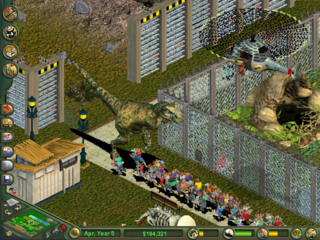
Consequently, you start looking for exploits that help you keep your dinosaurs contained for when your employees can't. One solution is to surround their cages with a moat, making these unusual high voltage castles. The logic is, if you can break these animals' pathing, you can thwart their escape attempts. But this is unsightly and slows down maintenance workers who have to now run inside of cages to bolster their failing walls. If you have the budget for it, a superior solution is to create two layers of fencing around your more fearsome beasts. Because the game world is made up of tiles, and you can place a fence piece on the edge of any tile, you can, for example, install a wall on the left edge of one square, and a wall on right edge of the square to the left of it, letting you stack two lines of fencing into the same space. As it's unlikely that both fence segments will degrade at the same time, it's improbable that a double-wrapped dinosaur will ever get an escape window.
It's a disappointment that these exploits are possible but even more so that they're necessary. Securing your dinosaurs takes you out of the headspace of a zoo director because you're no longer thinking about a world of concession stands, foliage, and ticket prices; you're thinking about one of conflicting AI and pathing. You're forced to speak to the game as a running program and not as a camera trained on a theme park. Yet, seen as a video game first, Dinosaur Digs is somewhat taking Zoo Tycoon back to its roots, converting it into a spiritual successor for DinoPark Tycoon.
Marine Mania
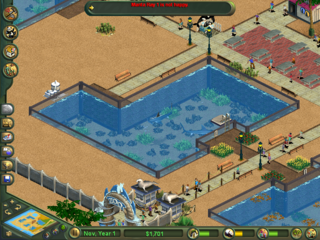
Zoo Tycoon's second and final expansion, Marine Mania, released the same year as Dinosaur Digs, 2002. Unlike Dinosaur Digs which imagines the places a zoo might go with futuristic technology at its disposal, Marine Mania covers an area of present zoos that the experience previously overlooked: subaquatic animals. Think dolphins, whales, manta rays, etc. Even more than the previous expansion, this package is about content over mechanics. There's no equivalent of the dino rescue team or the eggs this time around, and every routine you go through to care for these ocean lifeforms is one you go through for the terrestrial animals with the additions that sometimes you need to set up deeper tanks or water filters. These tanks tend to blur together visually, all being medium blue voids, just with different plants and rocks at their beds. This graphical homogeneity wasn't a problem with the exhibits before this expansion.
However, even if most glass enclosures look like most other glass enclosures, they appear, oddly, as more alien than even the prehistoric exhibits. Your pens for mammals, dinosaurs, and birds at least have land and trees which isn't the case for the Marine Mania exhibits. Yet, as you can find in Dinosaur Digs, the mechanical similarity between these expansion animals and those in the base game leaves all your zoo's residents united under the banner of a basic set of natural desires. Everyone, from gorillas to triceratops to sea turtles needs food, shelter, and the right habitat. The marine animals' tanks also function as the first three-dimensional exhibits in the game, and as you can adjust the height of them, you see more variation in the elevation of your zoo.
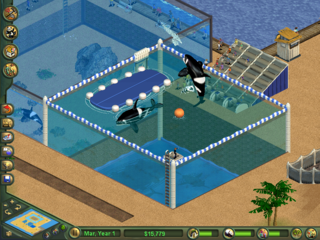
Marine Mania and Dinosaur Digs both use their mechanics in service of generating one big, flashy event in the park. For Dinosaur Digs that was the potential dinosaur breakout with all its associated panic and carnage, but that expansion motivated players to ensure that they never witnessed its big spectacle. Marine Mania encourages you towards its showcase events: the aquatic shows. You can place show tanks right up against regular water exhibits, buy some seating, draft up a list of tricks, and periodically, your animals and marine specialists will put on a little theatre. It's a well-meaning but imperfect addition. The fence breaches in Dinosaur Digs were uncommon enough that when one happened, you were fixated, but the water shows in Marine Mania are designed to cycle around every few minutes, and when the same breaching and diving animations play out day after day, it's only compelling for so long. Having said that, the shows add a new dimension to your animals' relationship to your zoo. Guests will point and coo for any lion equally, but they'll treat the orca that can balance a ball on its nose as more of a curiosity than the orca that can't. And you no longer have to release animals into an enclosure and just let them go about their business; you can now direct some of their behaviours to a financial and aesthetic end.
Conclusion
The Zoo Tycoon expansions build new wings onto the base experience's zoo director roleplay instead of transforming it at its foundation. But for what it's worth, we can treasure each new animal the expansions add beyond them just being more entries in a spreadsheet. While expansions in other games often add objects, missions, and areas to for us to discard once we've consumed them, the animals of Zoo Tycoon retain a sentimental value that gear or maps from other games don't usually do. A lot of that is down to us being able to track these representations of animals back to creatures in the real world which have qualities of personhood that swords or combat units typically don't. And that's a big part of what makes Zoo Tycoon work: We tend to get more attached to living things than we do to inanimate objects or faceless employees. The game takes the long-running history of business sims and introduces to it these pets which blur the line between attraction and living organism, and which require that we build highly detailed environments to keep them happy. Those environments create a developed image of a natural place, and because no two of us are going to fill out settings in the same way, we all get unique parks that we have a sense of ownership over. This was, at the time, rare in the genre. Thanks for reading.
Log in to comment